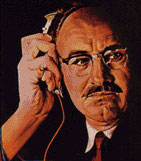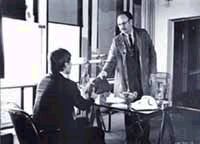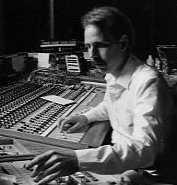|
While highly technical, Murch (egged on by Ondaatje) makes the art and craft of editing and mixing totally accessible to the lay reader. For here, after the fashioning of the script and directing of the film is the missing third act or chapter on film production: how films are made and remade in the editing and mixing suites.
The third act of film making itself breaks down into three sections. First is the image editing — the cutting/ editing of various camera angles, often with multiple takes — with the accompanying dialogue sound track. The second stage is soundtrack editing where various sound effects and atmospheric tracks (including things like footsteps) are laid down, as are multiple dialogue tracks — sometimes the actors will have been brought into the studio to ‘revoice’ their original dialogue for quality or creative purposes — and, lastly, multiple music tracks. The third stage is where are these tracks are mixed together, the end result being a digital stereophonic master track.
Murch is no ordinary up-through-the ranks technician. He’s bilingual with a smattering of numerous other languages — he is in fact highly educated and extremely widely read. He’s something of musicologist and a cultural theoretician. He doesn’t have a television in his house and is ignorant of much popular culture when it comes to film. The films he’s familiar are some of European and Asian classics he saw in a film study course at university. Murch has spent much of his career working with Francis Ford Coppola, firstly as a sound editor and rerecording mixer and then as film editor. He re-edited and remixed in stereo The Godfather trilogy as single unit.
Murch’s major contribution to editing and mixing is perhaps best illustrated by his work on Coppola’s movie, The Conversation (1974). Basically the story of surveillance technician, Coppola wanted to make film that was the sound equivalent of the visual mystery found in Antonioni’s Blow Up. The film was made between Godfathers I & II and it was huge creative and critical success but it was not a commercial success (unlike the Godfather films). More recently the film has been remixed in digital stereo.

Ondaatje: “. . .On one level it’s a thriller, but it also has that ambiguity we were talking about earlier. It’s got such a chiselled and obsessed point of view.”
Murch: “You know he’s (Harry Caul the surveillance technician played by Gene Hackman) been hired by the Director of a faceless corporation to secretly tape the conversation of a young couple who may or may not be having an affair. But since you only know what he knows, you never get the whole story... You just make assumptions... one of the main structural changes in The Conversation was necessitated when we realised that the audience found what Harry Caul does — his regular work — so mysterious that it was not only hard for them to understand but hard to understand the twists of this particular situation in which he finds himself.”
Onjadaatje: “...is it possible to get to get a different perspective through the soundtrack — not just from what we’re watching, but through sound as well?”
 Murch: “. . .sound is very malleable... where you don’t know what the point of view is at the opening. It’s clear only that you are very high up, looking down on Union square in San Francisco, hearing the soft, billowy sounds of the city at lunchtime. Then, like a jagged red line across the view, comes this distorted — you don’t know what it is — this digital racket,... you will learn that what you assumed was a neutral God’s-eye point of view is in fact the point of view of a secret tape recorder that is recording all of this, picking up these distorted sounds that are imperfectly recorded voices of the targets, the young couple’s conversation sometimes muffled by the square. But this is a shell game, a little mystery that progresses over the course of the film until you finally put the pieces together and realise what it is.
Murch: “. . .sound is very malleable... where you don’t know what the point of view is at the opening. It’s clear only that you are very high up, looking down on Union square in San Francisco, hearing the soft, billowy sounds of the city at lunchtime. Then, like a jagged red line across the view, comes this distorted — you don’t know what it is — this digital racket,... you will learn that what you assumed was a neutral God’s-eye point of view is in fact the point of view of a secret tape recorder that is recording all of this, picking up these distorted sounds that are imperfectly recorded voices of the targets, the young couple’s conversation sometimes muffled by the square. But this is a shell game, a little mystery that progresses over the course of the film until you finally put the pieces together and realise what it is.
Onjadaatje: “...because the abstract sound gets cleaned up and interpreted and therefore becomes Harry’s point of view, but in the end he totally misinterprets the one important sentence he’s recorded.”
Murch: “(Yes) ...we discover Harry has — all along — mentally altered the cadence of the line, which is hypersubjectivity. Because of what happened in the past, where people were killed as a result of his action. So he chooses which of his characters are likely to be innocent victims — the attractive young couple, particularly the girl. He doesn’t want to her to be hurt the way the previous people have been hurt, so once he finally decodes and clarifies the line — ‘He’d kill us if he got the chance’ — it becomes a mantra that in every situation reinforces the message he needs to hear: These people are victims... A line that has an innocent meaning at one time has a non-innocent meaning at the end... What sabotages him is the mental filter that chooses to hear an inflection that isn’t really there, because of his own past history.”
Whether you are interested in film scholarship or bluffing your way through a dinner party, or something in between, read this book, rent or buy the DVD or video of The Conversation and re-read the chapters on this film and you will be enriched.
* * * *
Murch has some interesting theories of the use of music in films and he explains at length throughout the book how music can colour if not change the feelings behind images. It’s hard not to agree with him from both a practical and theoretical point of view. Space prohibits a lengthy analysis but below is a taste of the material to be found in Ondaatje’s book.
“There was a crisis with Apocalypse Now... we didn’t have the rights to Georg Solti’s recording of The Ride of the Valkyries... Decca Europe refused to it give it us... I went to Tower Records and bought all nineteen recordings of... Valkyries... I eliminated all but one — Erich Leinsdorp conducting the L.A. Philharmonic... within ten seconds (I) knew it wasn’t going to work... not because of any metric (or synchronisation) problem — in fact it was quite close to Solti’s rhythms — but because of the colouration. At that moment (in the film) you’re looking down out of a helicopter, past a soldier, onto the waters of the Philippine gulf. There is a peculiarly wonderful acidity to the blue of the ocean that synergised with the metallic brass of Solti’s recording. With Leinsdorf, the strings had none of the brassiness — they were soft and pillowy — as a result the blue looked dead. It was no longer the same blue... Luckily Francis eventually got through to Solti himself... Solti said yes... and called the people at Decca. . . “
* * * *
Murch co-wrote with George Lucas’s THX 1138 (1970), the latter’s first film, and co-wrote his only outing as a director, Return to Oz (1985) with Gil Dennis.

Photo: Walter Murch at work
In response to the question: “Do you want to direct again”? Murch replied: “I learned something during the process, which is that I’m not temperamentally interested in directing for the sake of directing. Return to Oz was a project dear to my heart.”
Personally, I found Return to Oz, based L. Frank Baum’s books, Land of Oz and Ozma of Oz, antiseptic — in the figurative meaning of that word. The very theoretical qualities that Murch bought to structuring and re-structuring (especially on the sound designer side) other peoples’ work fails on his own set. His directing tone and style lacks an aesthetic and creative warmth.
* * * *
“Orson Welles once said in an interview in Cahier du Cinéma: For my style, for my vision of the cinema, editing is not simply one aspect: it’s the aspect. The notion of directing a film is the invention of critics like you [Cahier du Cinéma]. It isn’t an art, or at best it’s an art only one minute a day. That minute is terribly crucial, but it occurs very rarely. The only time one is able to exercise control over the film is in the editing. The images themselves are not sufficient. They’re very important, but they’re only images. What’s essential is the duration of each image and that which follows each image: the whole eloquence of cinema is that it’s achieved in the editing room.”
* * * *
For all his brilliance working side-by-side with the likes of Coppola, Murch’s work as film editor as distinct from a sound designer is, for me, more problematic. He seems to have an innate compulsion to smooth out important jagged edges in both, for example, The Unbearable Lightness of Being (1987) and The English Patient (1996). The former didn’t work for cinema goers who had not read Milan Kundera’s novel. They didn’t know what to expect. If Murch and director, Philip Kaufman, had structurally placed the death at the beginning and flashed back to the story (given Murch’s boast of continually restructuring films in the edit suite) then the spiritually terrifying but whimsical journey would have made more sense.
The editing of The Talented Mr. Ripley was overly tricksy — but that was nothing to the degree of aggravation I felt watching The English Patient — both films were written and directed by Anthony Minghella.
Ondaatje: I remember when you were accepting the Scripter Award for Anthony’s adaptation of The English Patient you read out the scene numbers of the screenplay and then you read the order of scenes as they finally played in the film. The eventual order was (instead of 1, 2, 3, 4) something like 1, 42, 2, 98 — everything seemed to have changed...’
Murch: ‘...the order of scenes often changes from what it was in the script. The Conversation was changed a lot. But in terms of its entanglements The English Patient was the most changed.
Agreed. I wrote about the editing of The English Patient in The Australian’s Review of Books — April 7th 1997, ‘Poetics goes AWOL.’
“Of the 180 or so scenes, at least 120 are not the phantasmagorical blood and guts of the cinema, but pretty illustrated Pinteresque set pieces that have been over-cooked in the editing suite. Minghella’s film, in its tasteful rage for order, clarity and brevity, has lost its soul in a hopeless, over-reaching quest for significance that transforms profundity into triviality . . .an award-winning, general audience “art-house” movie that perversely is much closer in both tone and substance to Mills and Boon than an Ondaatje novel. . . his (Ondaatje) attendance at mini-lectures and book signings with Minghella, has embraced this process with unstrained vigour.”
I don’t resile from these comments other than to note that Murch probably influenced Minghella in the edit suite more than the latter influenced Murch — a point alluded to in this book. As for Ondaatje, he was totally immersing himself in the aesthetics of film making and the razzle-dazzle side of the film business throughout The English Patient’s promotion and distribution period. At the time of writing the above piece I did not really comprehend Ondaatje’s motives (other than a commercial one). He had become intrigued by a different art form.
The result is this book, and lay readers, film students and professionals alike owe Ondaatje a debt of gratitude.
* * * *
Ondaatje: “Did you talk to people like Janet Leigh and Charlton Heston, or anyone else who worked with Welles (on Touch of Evil)?”
Murch: “We talked to them afterwards, when the work was done, and we screened the film for them. Janet Leigh was very emotional — it bought back everything to her, what they had set out to do so idealistically at the beginning.’
|
